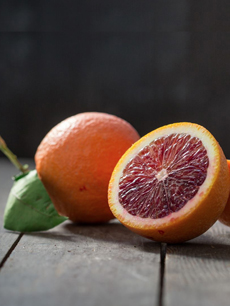Types Of Blood Oranges & Blood Orange Recipes
 A blood orange can be thing of beauty. Photo of the Moro variety courtesy GoodEggs.com. |
Blood orange season is upon us. Blood oranges can be a thrill (sweet and luscious) or a disappointment (bland), depending on the grower’s rootstock, the climate and the season. You never know what you’re going to get, but the upside is so wonderful that you’ve got to try. The hue of a blood orange can range from pink to rose red to deep purple. The most dramatic have “blood”-colored crimson and purple flesh. (There are even “blonde” blood oranges which have orange flesh like regular oranges, but a have blood orange flavor.) The peel may look like a regular orange or feature telltale washes of red. The skin may be smooth or pitted. While it looks like the more acidic Valencia orange on the outside, the blood orange flesh is sweet with less acid, like a navel orange. Each variety has a different climate preference, and produces different hues, sizes and flavors based on the climate, temperature and other factors that impact the coloration and flavor intensity. California blood oranges have more pigmentation, Texas blood oranges tend to have less pigmentation, as do those from Florida, where the humidity limits the development of the pigment. |
|
|
The color is the result of the antioxidant anthocyanin,* not typically found in citrus, but common to other red fruits and flowers (it’s the same natural chemical that gives the color to pomegranates and roses). The flavor of a good blood orange will be “an orange kissed by a raspberry.” Blood oranges are believed to be a mutation of the sweet orange, that occurred in southern Italy around 1850. The blood orange was brought to the U.S. in the 1930s in the wave of Italian immigration. It now grows in California (November to May), Florida (October to January) and Texas (December to March). *Anthocyanin neutralizes the effects of free-radical chemicals that are believed to cause cancer and other ailments (diabetes, epilepsy, heart disease, liver disease and ulcers) plus the general impact of aging. Research shows that it fights and prevents cancerous tumors and ulcers, and improves vision. Blood oranges are also packed with high levels of carotene, dietary fiber, potassium and vitamin C. |
||
|
TYPES OF BLOOD ORANGES The three most popular cultivars (varieties) of blood orange the Moro, Sanguiello and Tarocco. If you can get information from your vendor, go for the Moro or the Tarocco. |
 A cocktail with blood orange juice. Photo courtesy The Rose Group. |
|
|
BLOOD ORANGE RECIPES Our favorite way to enjoy blood oranges is as a hand fruit or a simple sorbet or granita. A glass of blood orange juice is also wonderful. When you have such a subtle, special flavor, you might not want to cover it up. However, here are a few recipes for those blessed with an abundance of blood oranges.
|
||


